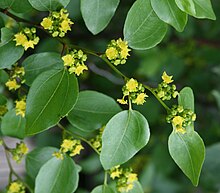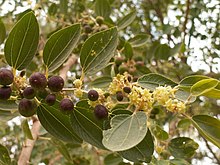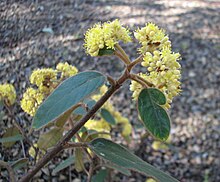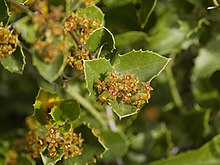Buckthorn family
| Buckthorn family | ||||||||||||
|---|---|---|---|---|---|---|---|---|---|---|---|---|

|
||||||||||||
| Systematics | ||||||||||||
|
||||||||||||
| Scientific name | ||||||||||||
| Rhamnaceae | ||||||||||||
| Yuss. |
The buckthorn family (Rhamnaceae) form a plant family in the order of the rose-like (Rosales). The approximately 52 genera with approximately 925 to 1000 species are distributed worldwide, particularly in the subtropics to the tropics.
Description and ecology

Vegetative characteristics
They are mostly evergreen or deciduous, woody plants: independently upright shrubs or trees , but also some lianas ; they are seldom perennial herbaceous plants ( Crumenaria ). They often have thorns . The roots sometimes form a symbiosis with the nitrogen-fixing Frankia .
Most alternate and spirally or rarely opposite, distributed to the stems or standing together on short shoots, arranged leaves usually have petioles. The simple leaf blades are entire or toothed. The stomata are mostly anomocytic or less often paracytic. The leaves can be transformed into thorns (for example Paliurus spina-christi and Colletia paradoxa ). If stipules are present, they may well be developed, reduced to scales, or transformed into thorns.
Generative characteristics
The flowers can stand individually up to several in the leaf axils or in differently structured inflorescences.
The radial symmetry flowers are usually quite small and are usually five-fold, rarely four-fold; they can be hermaphroditic or rarely unisexual. The flower cup (hypanthium) stands under the ovary, surrounds it or is partially fused with it. The five (rarely four), mostly nailed sepals are fused (sometimes tubular). The five (rarely four) petals are free and can be white, yellowish, greenish, pink or blue. There is only one circle with as many fertile stamens as petals; the stamens are opposite the petals, so the outer circle of the stamen is missing. The stamens are thin. The pollen grains usually have three apertures and are mostly colporat. The nectar-forming , thin to fleshy, smooth or lobed disc , which is located between the pistil and stamens, is very typical of the family ; but it can also be absent. Usually two to three (rarely five) carpels usually two- to above to below-earth, rare one, to vierkammerigen ovary grown. There are usually one, rarely two anatropic ovules per ovary chamber . The stylus ends in a simple scar or has the same number of scars as carpels. The pollination is effected by insects ( Entomophilie ).
It will capsule fruits , berries , drupes , winged nut fruits or schizocarps which decompose in dry part fruits formed. The seeds are dispersed depending on the species by the wind (then the seeds are winged), by mammals or birds. The well-formed embryo is straight.
ingredients
At flavonoids are kaempferol and quercetin present.











Systematics and distribution
The Rhamnaceae family was set up in 1789 under the name "Rhamni" by Antoine Laurent de Jussieu in Genera Plantarum , pp. 376–377. Synonyms for Rhamnaceae Juss. are Frangulaceae DC., Phylicaceae J.Agardh , Ziziphaceae Adans. ex Post & Kuntze and Cryptandraceae Barkley .
The buckthorn family is widespread around the world and can be found in a variety of habitats . However, the main distribution areas are tropical and subtropical regions, mainly forests.
The family Rhamnaceae contains 925 to 1000 species in 52 genera, which are placed in eleven tribe , seven genera are considered incertae sedis , their exact systematic position in the family is unclear. Some genera are in need of revision , as is the tribe Pomaderreae. The closest relatives of the Rhamnaceae family are Barbeya oleoides (= Barbeyaceae) and the Dirachma (= Dirachmaceae).
The eleven tribes with their genera are:
- Tribe Ampelozizipheae: It contains only one monotypic genus:
-
Ampelozizyphus Ducke : It contains only one species:
- Ampelozizyphus amazonicus Ducke : It is native to the Brazilian Amazon.
-
Ampelozizyphus Ducke : It contains only one species:
- Tribe Bathiorhamneae: It contains only one genus:
- Bathiorhamnus Capuron : The seven or so species occur only in Madagascar.
- Tribe Colletieae : It contains about six genera:
- Adolphia Meisn. : One or two species occur in California, Texas, and Mexico.
- Colletia Comm. ex Juss. : It contains at least five types.
- Discaria Hook. : It has a disjoint area . Of the eight or so species, two are found in Australia, the others in South America and New Zealand.
-
Kentrothamnus Suess. & Overkott : It contains only one species:
- Kentrothamnus weddellianus (Miers) MCJohnst. : It occurs in Bolivia.
- Retanilla (DC.) Brongn. : The four or so species occur in southern South America.
-
Trevoa Miers ex Hook. (in some authors with Talguenea Miers ex Endl. ): It contains only one species:
- Trevoa quinquenervia Gillies & Hook. : It occurs only in central Chile.
- Tribus Doerpfeldieae :
- Tribus Gouanieae : It contains about six genera:
-
Alvimiantha Gray-Wilson : It contains only one species:
- Alvimiantha tricamerata Gray-Wilson : It occurs in Brazil.
- Crumenaria Mart. : Of the approximately six species, five occur in northeastern Argentina as well as tropical Brazil and one in Guatemala.
- Gouania Jacq. : The approximately 20 to 50 species thrive in the tropics and subtropics.
- Helinus E. Mey. ex Endl. : Of the five or so species, three are found in eastern and southern Africa and one each in India and Madagascar.
-
Johnstonalia Tortosa (Syn .: Johnstonia Tortosa nom. Illegit.): It contains only one species:
- Johnstonalia axilliflora (MCJohnst.) Tortosa : It occurs in Peru.
-
Reissekia Endl. : With only one type:
- Reissekia smilacina (Sm.) Steud. : It occurs in Brazil.
-
Alvimiantha Gray-Wilson : It contains only one species:
- Tribe Maesopsideae: It contains only one monotypical genus:
-
Maesopsis Engl .: It contains only one species:
- Maesopsis eminii Engl .: It is common in tropical Africa.
-
Maesopsis Engl .: It contains only one species:
- Tribus Paliureae : It contains three genera with around 100 species:
- Hovenia Thunb. : There are only three species left in India, Bhutan, Nepal, Myanmar, China (three species), Korea and Japan.
- Paliurus Mill .: Of the approximately five species, one occurs in the Mediterranean area and the other in eastern Asia.
- Ziziphus Mill . : they spread in pantropical; the 100 or so species are mainly found in the Neotropic and Southeast Asia.
- Tribe Phyliceae :
-
Nesiota Hook. f. : It contains only one type:
- St. Helena olive tree ( Nesiota elliptica (Roxb.) Hook. F. ): This species is endemic to the island of St. Helena in the South Atlantic; it has been considered extinct since 2003.
-
Noltea Rchb. : It contains only one type:
- Noltea africana (L.) Endl. : It originally only occurs in the South African province of Eastern Cape and is a neophyte in Australia.
-
Trichocephalus Brongn. : It contains only one type:
- Trichocephalus stipularis Brongn. : It is common in southern Africa.
- Phylica L .: The 13 or so species are mostly found in southern Africa.
-
Nesiota Hook. f. : It contains only one type:
- Tribus Pomaderreae : The approximately six genera occur mainly in Australia and about nine species in New Zealand:
-
Blackallia C.A.Gardner : It contains only one species:
- Blackallia nudiflora (F.Muell.) Rye & Kellermann : It occurs in Australia.
- Cryptandra Sm. (Including Stenanthemum Reissek ): The approximately 40 to 57 species are widespread in Australia.
- Pomaderris Labill. : Of the approximately 70 species, 65 occur in Australia, of which 61 occur only there and only nine in New Zealand, of which five occur only there. They mainly thrive in temperate, slightly wetter areas.
-
Siegfriedia C.A. Gardner : It contains only one species:
- Siegfriedia darwinioides C.A. Gardner : It occurs in western Australia.
- Spyridium Fenzl : The 30 or so species occur in Australia.
- Trymalium Fenzl : The eleven or so species occur in Australia.
-
Blackallia C.A.Gardner : It contains only one species:
- Tribe Rhamneae : It contains about twelve genera:
- Auerodendron Urb. : The seven or so species occur in the Greater Antilles .
- Berchemia Neck. ex DC. : The approximately 32 species occur mainly in temperate and tropical areas from eastern Asia to Southeast Asia. There are 19 species in China, twelve of them only there.
- Berchemiella Nakai : Of the only three species, two occur only in China and one only in Japan.
- Condalia Cav. : The 20 or so species thrive in arid areas of the New World.
-
Dallachya F. Muell. with only one kind:
- Dallachya vitiensis ( Benth. ) F.Muell.
- Karwinskia Zucc. : The approximately 15 species are widespread in the Neotropic.
-
Krugiodendron Urb. : It contains only one type:
- Krugiodendron ferreum (Vahl) Urb. : It occurs in the West Indies .
- Reynosia Griseb. : The maximum 16 species occur in Florida and on the West Indies.
- Rhamnella Miq. : The eight or so species are distributed in central China, Korea and Japan. All eight species occur in China, five of them only there.
- Rhamnidium Reissek : The four to twelve species occur in the Neotropic.
- Buckthorn ( Rhamnus L. , including Frangula Mill. ): The 100 to 150 species are widespread in the northern hemisphere.
- Sageretia Brongn. : Most of the 35 species are found in Southeast Asia, and only a few in Africa and North America. There are 19 species in China, 15 of them only there.
- Scutia (Comm. Ex DC.) Brongn. : Of the approximately five species, one occurs in the Paleotropic and the other in tropical South America.
- Tribus Ventilagineae :
- Genera incertae sedis :
- Alphitonia Reissek ex Endl. : The 15 to 20 species occur in Southeast Asia, Malesia, Australia (six species), New Caledonia and on the western Pacific islands.
- Sacred flowers ( Ceanothus L. ): The 50 to 60 species are common in North and Central America.
- Colubrina Rich. ex Brongn. : The 23 to 31 species occur in the tropics almost worldwide.
- Emmenosperma F. Muell. : The five or so species are found in Australia (two species), New Zealand, New Caledonia and the Fiji Islands.
-
Lasiodiscus Hook. f. : It probably contains only one type:
- Lasiodiscus fasciculiflorus Engl .: It occurs in tropical Africa.
-
Schistocarpaea F. Muell. : It contains only one type:
- Schistocarpaea johnsonii F. Muell. : It occurs in Australia.
- Talguenea Miers ex Endl. : There are at most two species in Chile.
Paleobotany
There is a leaf imprint from the Upper Cretaceous , but its attribution to the buckthorn family is not entirely clear; a flower from the Middle Cretaceous ( Nebraska ) was also described as a buckthorn family . However, reliable fossil records can only be found in the Tertiary , leaves in the Eocene ( Berhamniphyllum ) and the earliest pollen from the Oligocene .
use
Some species such as buckthorn and buckthorn are used to obtain medicines. Laxatives (cascara sagrada) are obtained from the bark, leaves and fruits of especially Rhamnus cathartica , Rhamnus frangula , Rhamnus purshiana and Ceanothus reclinatus . Ziziphus species such as Indian jujube ( Ziziphus mauritiana ) and Chinese jujube ( Ziziphus jujuba ) are grown for their edible fruits. The inflorescence stems are eaten by Hovenia dulcis .
The dried berries of buckthorn species were used for coloring and as a color varnish under the name Schüttgelb . The wood from Alphitonia , Colubrina , Hovenia and Ziziphus species is used in a variety of ways.
Some Hovenia , Paliurus , and Rhamnus species are used as ornamental plants .
swell
- The Rhamnaceae family on the AP website. (Sections systematics and description)
- The Rhamnaceae family at DELTA by L. Watson & MJ Dallwitz. (Section description)
- Yilin Chen & Carsten Schirarend: Rhamnaceae , p. 115 - same text online as the printed work , In: Wu Zheng-yi, Peter H. Raven & Deyuan Hong (Eds.): Flora of China , Volume 12 - Hippocastanaceae through Theaceae , Science Press and Missouri Botanical Garden Press, Beijing and St. Louis, 2007. ISBN 978-1-930723-64-1 (Description, Distribution, and Usage Sections)
- John O. Sawyer, Jr .: The Rhamnaceae Family at Jepson eFlora , 2012. (Systematics and Description Sections)
- GJ Harden: Rhamnaceae in the New South Wales Flora Online . (Sections systematics and description)
- Leslie Watson, 2008: Datasheet in the Western Australian Flora and Genera List. (Sections systematics and description)
Individual evidence
- ↑ a b c d e The Rhamnaceae family at DELTA by L. Watson & MJ Dallwitz.
- ↑ a b c d e f John O. Sawyer, Jr .: The Rhamnaceae Family at Jepson eFlora , 2012.
- ↑ a b c d e f g h GJ Harden: Rhamnaceae in the New South Wales Flora Online .
- ^ A b Rhamnaceae in the Germplasm Resources Information Network (GRIN), USDA , ARS , National Genetic Resources Program. National Germplasm Resources Laboratory, Beltsville, Maryland. Retrieved July 29, 2013.
- ↑ a b c d D. Medan, C. Schirarend: Rhamnaceae In: Klaus Kubitzki (Ed.): The Families and Genera of Vascular Plants - Volume VI - Flowering Plants - Dicotyledons - Celastrales, Oxalidales, Rosales, Cornales, Ericales , 2004 , ISBN 978-3-540-06512-8
- ↑ Doerpfeldia cubensis in the endangered Red List species the IUCN 2013. Posted by: AE Areces-Mallea, 1998. Accessed August 10, 2013.
- ↑ a b c d e Yilin Chen & Carsten Schirarend: Rhamnaceae , p. 115 - the same text online as the printed work , In: Wu Zheng-yi, Peter H. Raven & Deyuan Hong (eds.): Flora of China , Volume 12 - Hippocastanaceae through Theaceae , Science Press and Missouri Botanical Garden Press, Beijing and St. Louis, 2007. ISBN 978-1-930723-64-1
- ↑ a b Leslie Watson, 2008: Entry in the Western Australian Flora .
- ^ Thomas N. Taylor, Edith L. Taylor: The Biology and Evolution of Fossil Plants . Prentice Hall, Englewood Cliffs 1993. ISBN 0-13-651589-4 , p. 787.